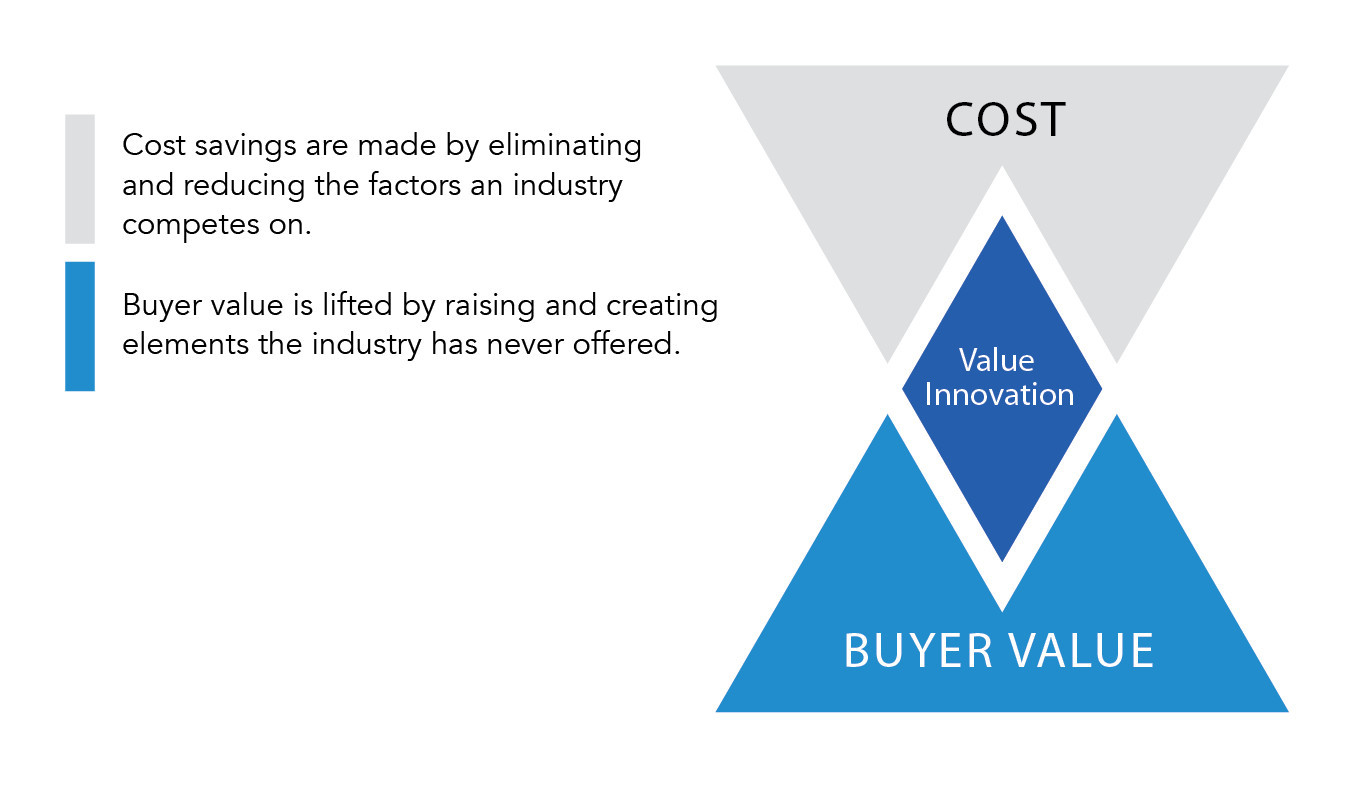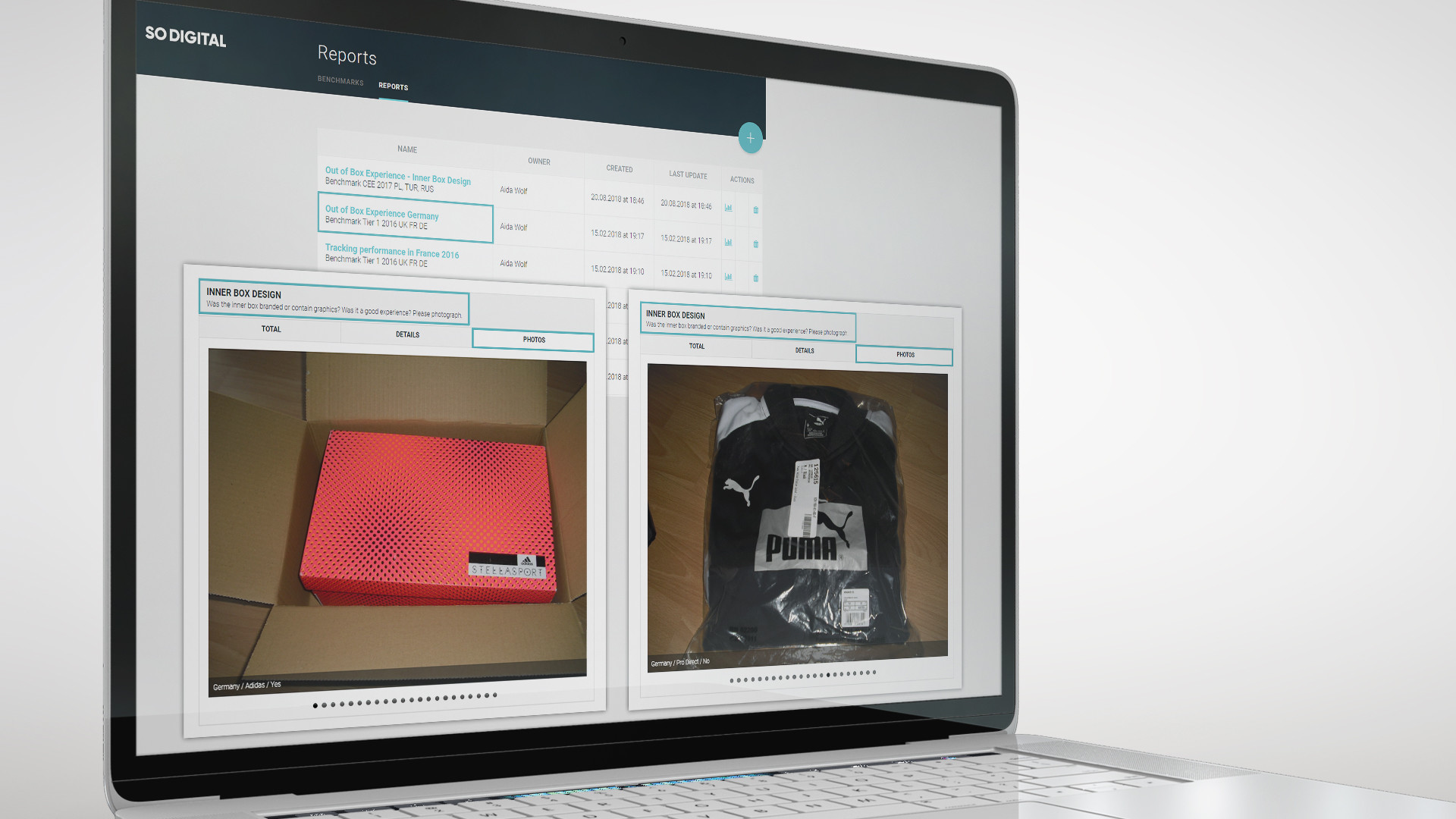We help brands drive internal capability, operational and executional improvements to achieve excellence in brand, creative and e-commerce strategy execution. Providing services and solutions across strategy management, internal enablement, capability building and executional support provision.
Flagship clients
 (EMEA) 14 markets
(EMEA) 14 markets
 (EMEA) 47 markets
(EMEA) 47 markets
 (EMEA) 17 markets
(EMEA) 17 markets
 (WHQ)
(WHQ)
Changing consumer purchasing habits and digitizing paths to purchase created a demise for many industries. Largely unprepared for fast paced market and marketing environment change, traditional and undifferentiated brick-and-mortar retailers perhaps got most of this beating. As physical store foot-traffic transformed to online websites traffic of both large and niche e-commerce players, the reality of retail bankruptcies and store closures settled in. However, as the proverb says "one man's loss is another man's gain" - with malaise settling in the traditional retail sector on one side, logistics providers' industry on the other side was invigorated with the new value proposition of e-commerce. Riding the tidal wave of change logistics providers, parcel providers and courier and express providers and other connected industries catering to e-commerce businesses are flourishing. Facts and figures from the IPC Global Postal Industry Report 2018, covering 50 postal operators worldwide along with major integrators, reporting on individual performance as well as factors such as digitisation, e-commerce and diversification in the postal industry, notes that parcels & logistics are driving the industry growth.
As e-commerce grows worldwide, posts are delivering more parcels than ever before.
As e-commerce grows worldwide, posts are delivering more parcels than ever before. But as they leverage their dense networks and improve, innovate and expand their B2C services, a diverse array of old and new players are shaking up the vibrant parcels market. Report finds that on the one hand, the traditional core business of mail delivery is in decline as communications move online; on the other, the industry faces fierce competition in the rapidly-growing e-commerce parcel market. As a result, posts are shifting from state-owned monopolies to commercial companies, from mail dependency to diversified portfolios and from a well-charted history into a dynamic, uncertain future.
From mail dependency to diversified portfolios and from a well-charted history into a dynamic, uncertain future.
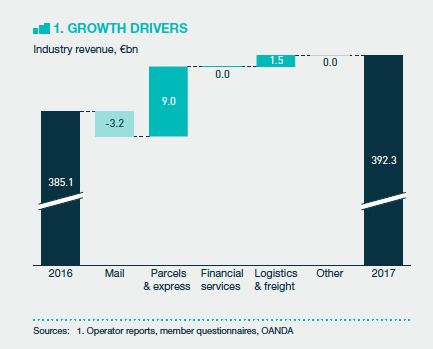
On aggregate, total postal industry revenue reached €392.3bn in 2017, up €7.2bn on 2016 results. Mail revenue fell €3.2bn as structural volume declines were in part offset by price increases. Fuelled by e-commerce, parcels and logistics were the two engines of industry growth in 2017, up €9.0bn and €1.5bn respectively. As shoppers move online, e-retailers large and small are busily dispatching more parcels. On aggregate, the postal industry’s parcel volume has more than doubled over the last decade. While impressive, the growth in parcels delivered by posts still lags behind that of online retail which almost quadrupled over the same period.
The growth in parcels delivered by posts still lags behind that of online retail which almost quadrupled over the same period.
Holger Winklbauer, CEO of IPC said: “E-commerce continues to fuel the industry. Posts are delivering more packets and parcels than ever before. While growth rates ranged widely, more than two thirds of posts saw stable or increasing revenues during the year and most cited parcels and express as a key growth driver.”
Intensifying Market Competition
Behind the media headlines of flashy brands and retailers that outcompete each other with innovative services and business model, e-commerce parcel and logistics providers' market is heating up with intensified competition. A diverse range of players old and new are shaking up the parcels market. Global integrators like UPS are complementing traditional B2B express services with new B2C models. E-retail giants such as JD.com are investing in logistics and flexing their digital muscle. And tech-driven, asset-light start-ups like Deliv are crowdsourcing the last mile. Meanwhile, posts continue to leverage their vast physical presence and dense networks as they innovate, improve and expand their B2C services. Many are teaming up with integrators, e-retailers and start-ups to further bolster e-commerce volumes. Others are introducing same-day shipping, offering real-time tracking and trialling drone, robot and car boot delivery. As a result, parcels volume growth rose to 14.3% on average in 2017.
A diverse range of players old and new are shaking up the parcels market.
Value Innovate To Stay Ahead of Competition
E-commerce is driving a renaissance across logistics & transport operations and connected industries. E-Commerce logistics market is expected to reach $535,895 million by 2022, supported by a CAGR of 21.2%. Logistics Trends & Insights (Logistics TI) said a renaissance appears to be underway in the global airfreight market, spurred not just by strong export orders but also by cross-border e-commerce, which is contributing to inventory replenishment and individual consumer demands. AT Kearney estimated cross-border items that were shipped in 13 European countries (up to 70kg) to €16.2bn / 720m items for 2016 and an increase of 25% by 2019 . High diversity of carriers in the European parcel markets sets the stage for high and intensifying competition. To stay ahead of the competitors, e-commerce logistics and parcel providers, as well as connected industries must continually provide value innovation.
To stay ahead of the competitors, e-commerce logistics providers must continually provide value innovation.
Product Innovation vs. Value Innovation
Now, there is a big difference between Product Innovation and (customer) Value Innovation. At the core level the difference is that Product Innovation doesn't necessarily have customers in mind and often it actually has a company and it's sales in mind. Product innovations aretechnology driven innovations that may or may not offer customers additional value. On the other side value innovation starts with customers in mind.
Blue Ocean Strategy Value Innovation Model
Value Innovation is the simultaneous pursuit of differentiation and low cost, creating a leap in value for both buyers and the company. The concept of Value Innovation is developed by W. Chan Kim and Renée Mauborgne and is the cornerstone of market-creating strategy. Because value to buyers comes from the offering’s utility minus its price, and because value to the company is generated from the offering’s price minus its cost, value innovation is achieved only when the whole system of utility, price, and cost is aligned.
Value Innovation starts with customer perspective and looks at the Buyer Utility (Map) and how to increase elements of it.
Average customers expectations which shape the value perceptions across countries and drive e-retailers e-commerce needs are the place to start value innovating.
Obviously, to value innovate, one must know the customers, what they perceive as valuable as well as the customer's customers. Average customers expectations which shape the value perceptions across countries and drive e-retailers e-commerce needs when it comes to logistics and parcel solutions are of outmost importance and the right place to start value innovating.
As in Europe and globally cross-border e-commerce is growing and there are clear indications that growth of cross-border items outperforms growth of domestic items shipped, knowing local market and country consumer preferences and value perceptions are an imperative. AT Kearney estimated cross-border items that were shipped in 13 European countries (up to 70kg) to €16.2bn / 720m items for 2016 and an increase of 25% by 2019. According to DHL analysis, cross-border items are growing at about 20-25% at present. Major cross-border flows from China, Germany and the UK to all EU28/EEA countries while there are important flows between neighbouring countries that promote emergence of ‘country clusters’ in e-commerce and delivery - Nordics, Benelux etc.
As growth of cross-border items outperforms growth of domestic items shipped, knowing local market and country consumer preferences and value perceptions are an imperative
SO DIGITAL GLOBAL E-COMMERCE BRAND EXCELLENCE PLATFORM is a management tool that helps e-commerce logistics and parcel solutions providers formulate, evaluate, and improve their e-commerce client value propositions by providing a systematic assessment of competitive performance of post-purchase and delivery performance of leading e-commerce market players across markets. Trained researches in target countries perform actual purchase of products from target e-retailers, recording their every step, while answering standardised scale based scorecard with average 200 data points to provide insight into comparative performance of e-retailers as well as e-commerce logistics and parcel solutions providers.
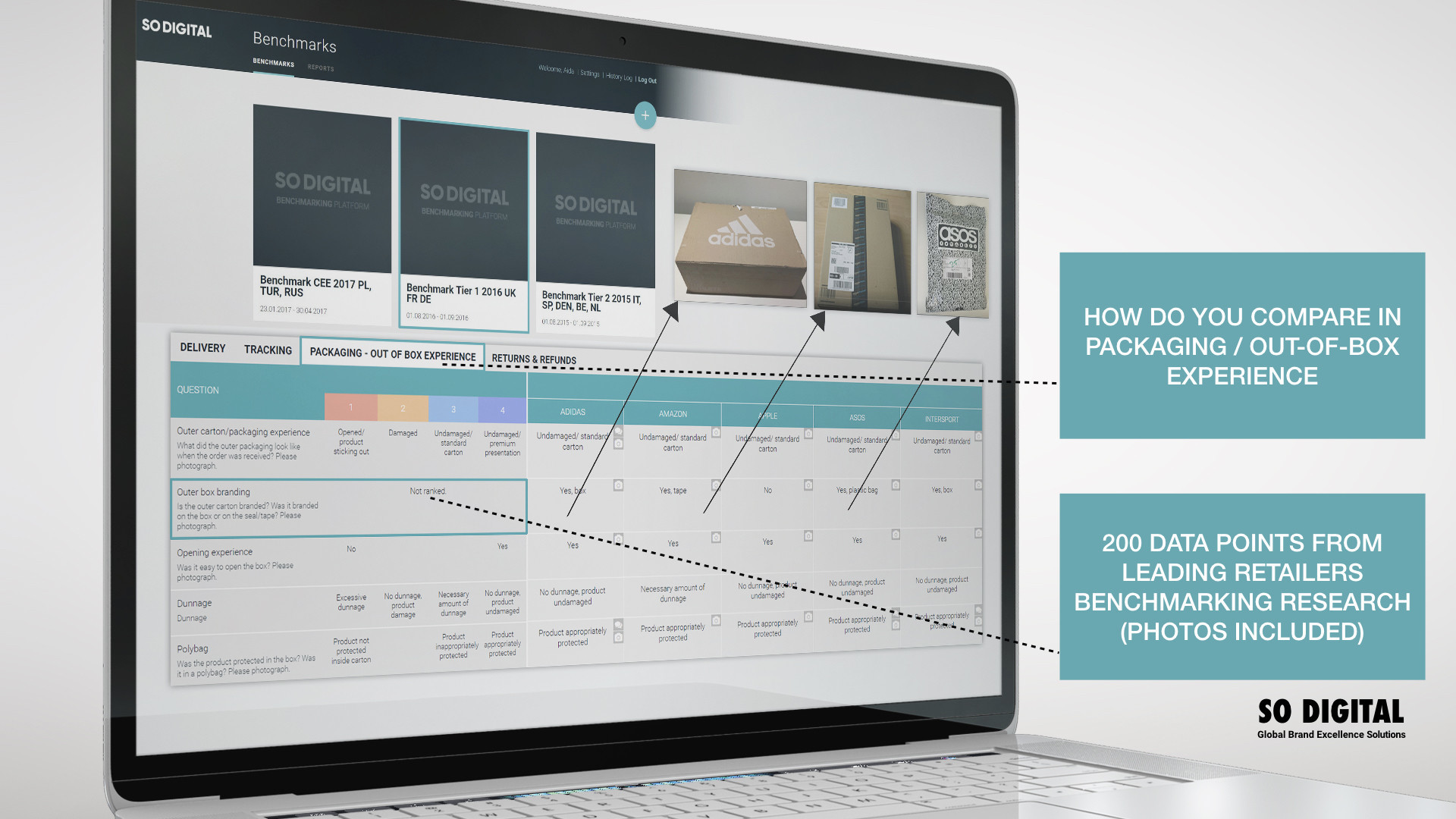
In this way, they learn how well the targets perform and, more importantly, the business processes that explain why these firms are successful.
Benchmarking is a tool for the systematic assessment of the competitive power of an enterprise. It is a process of comparing one's business processes and performance metrics to industry bests or best practices from other companies. In the process of best practice benchmarking, management identifies the best firms in their industry, or in another industry where similar processes exist, and compares the results and processes of those studied (the"targets") to one's own results and processes. In this way, they learn how well the targets perform and, more importantly, the business processes that explain why these firms are successful. Strategic benchmarking focuses on how companies compete. This form of benchmarking looks at what strategies the organisations are using to make them successful. Insights gained from strategic benchmarking results will be your definitive guide to determine across which dimensions the target market competes and across which dimensions of post-purchase you can differentiate while taking into account the established market averages to make value innovating e-commerce solutions.
Strategic benchmarking of post-purchase performance of leading e-retailers is at the heart of the SO DIGITAL GLOBAL E-COMMERCE BRAND EXCELLENCE PLATFORM. Our platform enables competitive cross industry performance benchmarking of best performing e-retailers across dimensions of postpurchase experience, including but not limited to, phases of delivery, tracking, packaging - out of box experience, and return & refunds. Market benchmarking results can be compiled into user made customisable reports - per dimension of shopping experience, data point, retailer, country etc. to enable market (average) performance comparison and learning insights. It is a management tool that helps companies formulate, evaluate, and improve their e-commerce value proposition strategies by providing a systematic assessment of competitive performance of post-purchase experience across markets.
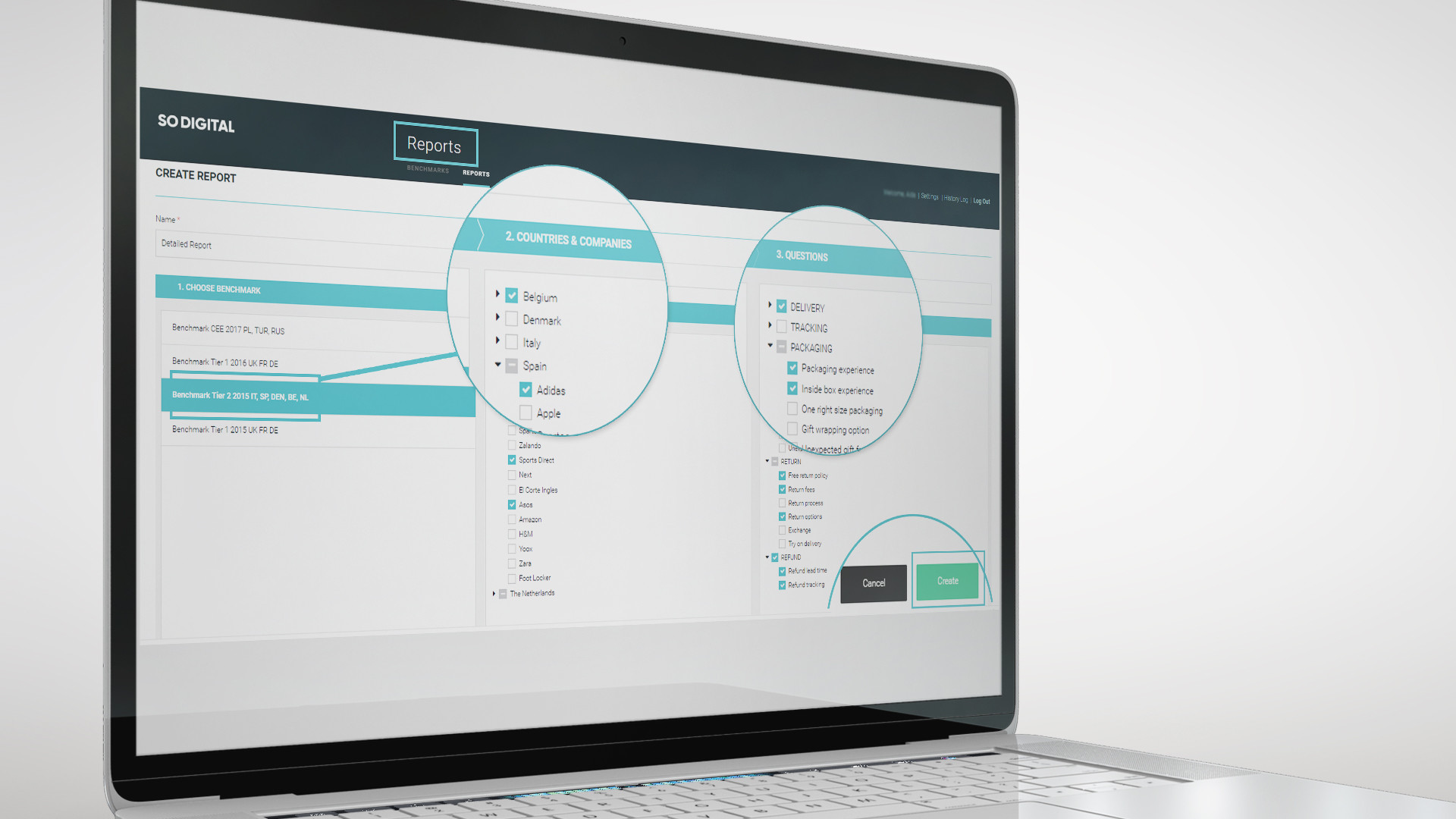
Disabled by lack of systematic assessment insight into it’s competitive position and dynamics of competition within and across markets, global logistics solution providers professionals risk making faulty market steps and costly mistakes by applying “one-size-fits-all” approach which ignores country distinct consumer preferences shaped by e-commerce market maturity and local players.
To start driving your eCommerce growth by value innovating contact us today for a free no-commitment one-on-one walk through of the solution & service and use client case of Nike (EMEA).
--------------------------------------------------------------------------------------------------------------
References :
Global Postal Industry Report 2018, IPC (International Postal Corporation) https://www.ipc.be/sector-data/postal-sector/key-findings
Romelda Ascutia, "E-commerce invigorating airfreight industry " | PortCalls Asia | Asian Shipping and Maritime News https://www.portcalls.com/ecommerce-invigorating-airfreight-industry/
E-Commerce Logistics Market to Garner $535,895 Million, Globally, by 2022 https://www.alliedmarketresearch.com/e-commerce-logistics-market
Ferry Salehi, Lars Ryssel: " Europe's CEP Market: Growth on New Terms" , At Kearney. http://www.atkearney.es/paper/-/asset_publisher/dVxv4Hz2h8bS/content/europe-s-cep-market-growth-on-new-terms/10192
Tim Docking: "The impact of E-commerce on the Postal Industry" , IBM Government technology solutions, https://www.ibm.com/blogs/insights-on-business/government/the-impact-of-e-commerce-on-the-postal-industry/
Alex Dieke " Assessment of EU Parcel Delivery Markets" https://www.emota.eu/media/1543/5_20181203_wik_grow_parcelsstudy_pdc.pdf
